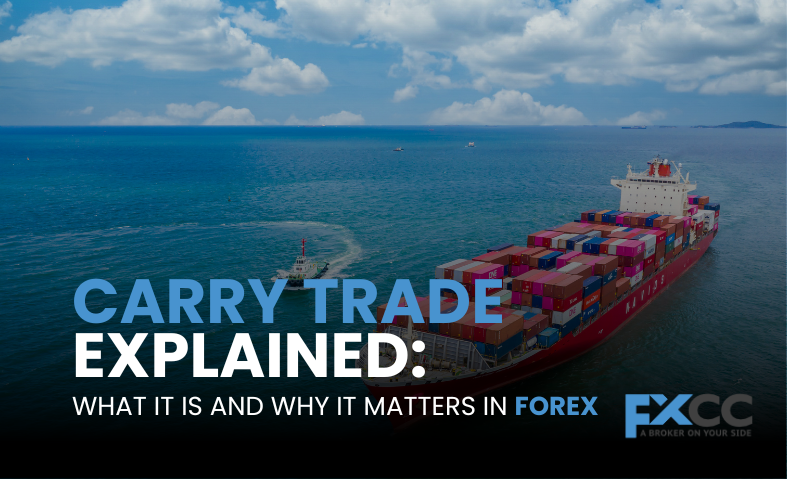Forex trading is a dynamic and fast-paced market, filled with strategies that cater to traders of all kinds. Among these strategies, the carry trade stands out as a popular and potentially profitable approach. But what exactly is a carry trade, and why does it matter in forex? Let’s simplify it for better understanding.
What is a Carry Trade?
In the forex market, a carry trade is a strategy where traders borrow money in a currency with a low interest rate and invest it in a currency with a higher interest rate. The goal is to profit from the difference in interest rates between the two currencies, known as the interest rate differential.

For example:
- Suppose the interest rate in Japan is 0.5%, and the interest rate in Australia is 4%.
- A trader might borrow Japanese yen and use it to buy Australian dollars.
- As long as the Australian dollar remains stable or appreciates, the trader earns the interest rate differential (4% – 0.5% = 3.5%).
This seemingly simple concept can lead to significant profits when leveraged properly, but it also comes with its risks.
Why Does the Carry Trade Matter in Forex?
- Potential for High Returns The main allure of the carry trade is its potential for consistent profits. By holding onto a currency with a higher interest rate, traders can earn returns daily through rollover payments.
- Influence on Currency Movements Carry trades can significantly impact the forex market. When large volumes of money flow into higher-yielding currencies, their value tends to rise, creating a self-reinforcing trend.
- Low Volatility Benefits In stable markets, carry trades thrive because currencies don’t fluctuate wildly. This stability allows traders to earn interest rate differentials with minimal risk.
- Economic Insights Carry trades reflect broader economic trends. For instance, they highlight global investor confidence and risk sentiment. When traders are optimistic, they’re more likely to pursue carry trades in higher-risk currencies.
How Does the Carry Trade Work?
To understand the mechanics of a carry trade, let’s consider the steps:
- Choosing the Currencies, select a currency pair with a significant interest rate differential. Popular pairs include:
- AUD/JPY (Australian Dollar/Japanese Yen)
- NZD/JPY (New Zealand Dollar/Japanese Yen)
- Borrowing the Low-Yield Currency Use a margin account to borrow a low-interest-rate currency (e.g., Japanese yen).
- Buying the High-Yield Currency Convert the borrowed funds into a higher-interest-rate currency (e.g., Australian dollars).
- Earning the Interest Differential Hold the high-yield currency in your account and earn daily interest payments, known as the swap rate.
- Monitoring the Trade Regularly tracks market conditions. Currency values, economic news, or shifts in interest rates can affect your trade.
What Are the Risks of Carry Trades?
While the carry trade is appealing, it’s not without risks:
- Currency Fluctuations Exchange rates can change unpredictably. If the higher-yielding currency depreciates against the borrowed currency, losses can outweigh interest gains.
- Interest Rate Changes Central banks adjust interest rates based on economic conditions. A rate hike in the low-yield currency or a cut in the high-yield one can erode the interest differential.
- Market Volatility Sudden economic events or geopolitical tensions can cause sharp currency movements, increasing the risk of losses.
- Leverage Many carry trades are leveraged, meaning traders use borrowed funds to amplify their positions. While this can magnify gains, it also increases potential losses.
Who Uses Carry Trades?
Carry trades are popular among:
- Retail Forex Traders: Individual investors looking for steady returns.
- Hedge Funds and Institutions: Large-scale investors seeking to profit from global interest rate disparities.
- Central Banks: Occasionally, they use carry trades to manage reserves and stabilize currencies.
Tips for Successful Carry Trading
- Choose Stable Currencies Focus on countries with strong economies and predictable monetary policies.
- Monitor Economic Indicators Keep an eye on interest rate announcements, GDP data, and inflation reports.
- Use Stop-Loss Orders Protect your capital by setting stop-loss levels to limit potential losses.
- Avoid Over-Leveraging Trade within your risk tolerance. Excessive leverage can wipe out your account quickly.
FAQs About Carry Trade in Forex
1. What is a swap rate in forex trading?
A swap rate is the interest earned or paid for holding a currency pair overnight. It’s determined by the interest rate differential between the two currencies.
2. Can beginners try carry trading?
While beginners can try to carry trading, it’s recommended to gain experience in forex trading first. Understanding market dynamics and risks is essential.
3. Is carry trading profitable?
Carry trading can be profitable, especially in low-volatility markets. However, success depends on careful analysis, risk management, and timing.
4. How do interest rates affect carry trades?
Higher interest rate differentials increase the appeal of carry trades, while changes in rates can impact profitability.
5. Which currencies are best for carry trades?
Currencies like the Australian dollar (AUD), New Zealand dollar (NZD), and Japanese yen (JPY) are popular due to their significant interest rate differences.

The carry trade is a fascinating strategy in the forex market, offering the potential for steady returns when executed correctly. By leveraging interest rate differentials and maintaining a keen eye on market conditions, traders can capitalize on this approach. However, as with any strategy, success comes down to preparation, discipline, and a solid understanding of the risks involved.


